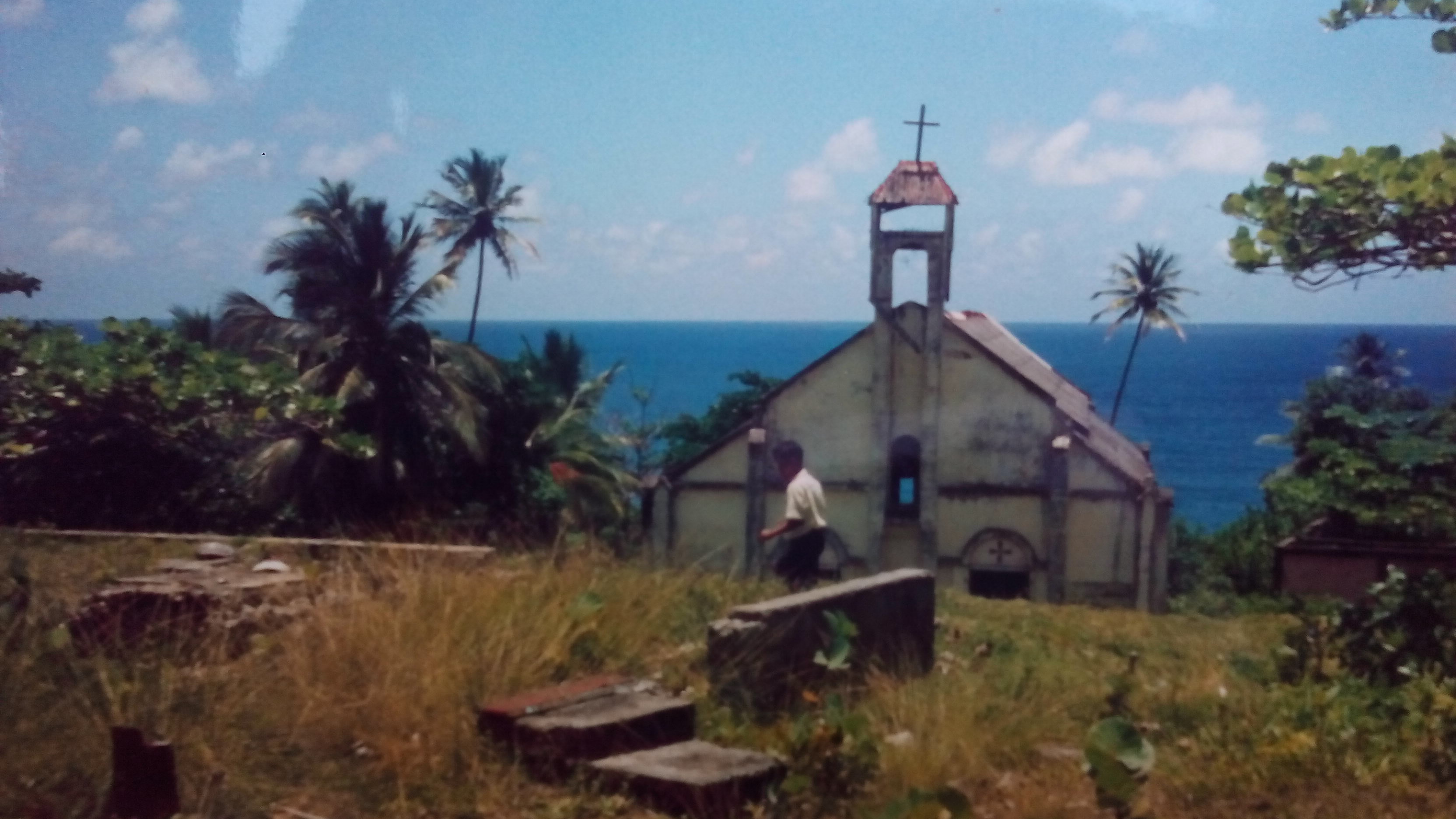by Bernard Lauwyck

a bird’s eye view of the old church in 1980
The Salybia church built by FMI Frs. Daniel Couturier [ +1895] and Jean Bellaudeau [ + 1912] , between 1893 and 1900, did not stand the test of time.
Fr. Jean Baptiste Barreau, FMI [ +1952] arrived in 1913 from St. Lucia to serve the Lasoie district and the Carib Quarter. He soon started a new church in Salybia.
He did not want a timber building, which requires constant repairs, but a strong durable building. He imported from St. Lucia a handpress to make cement blocks. As Salybia had no sand and cement, sand had to be hauled from afar and cement had to be shipped and landed in the Marigot Bay, a distance of several miles. “The pastor convened all the Caribs of goodwill and asked them if they were willing to help him to build a beautiful church for them. They all promised their wholehearted support and help. Some would donate cement, others would provide voluntary labour. A start was made. But soon the goodwill of the Caribs sank into the sole of their feet; and when the hurricane of 1916 swept over the island, the walls of the Carib church were barely finished.” [ source : the ECCLESIASTICAL BULLETIN OF ROSEAU (EBR) ]

Above : The ruins in December 2014
With time and the grace of God they succeeded. In the EBR of June 1925 we find a description of the Salybia church, which was almost, but not quite, completed . The occasion was a visit of Bishop James Moris on a Confirmation tour : “ been welcomed by hundreds of the tribe along the road , we arrived at the pretty little church….Fr. Barreau is to be congratulated on having brought to completion in a relatively short space of time the two substantial churches of Lasoie and St. Marie and decorated them in such a way as becomes the House of God. ..The altar of St. Marie, the handwork of Fr. Barreau himself, is made on a … monumental scale and handsomely painted and decorated. The artistic statue of Our Lady of Lourdes, nestled high up in a beautiful niche presents a ravishing sight, irresistibly draws the eyes of those who enter the church and raises their heart in veneration to the Immaculate Mother of God… Once the missing windows and pews will be finished, the choirloft built and a coat of paint applied, the church of St. Marie will be one of the coziest of the island ”. So ended Bishop Moris’ description.
This church survived the hurricanes of 1926 and 1928 but on September 1, 1930 a destructive violent hurricane reduced it to a heap of rubble. When the messenger reported the destruction of the church to the Bishop, he used the expression: “Our church is crushed like farine.” Bishop Moris wrote : “ Sainte Marie of Salybia fared the worst. There the new church, built after the hurricane of 1916 was leveled to the ground, the school house entirely broken to pieces and the presbytery damaged”. [ EBR September 1930]
Later that same month, on September 19th 1930 policemen arrived with the aim of seizing goods allegedly imported from Marie Galante, Martinique and Guadeloupe without payment of import duties. When they met resistance during searches at Salybia they shot four local men, two of which died. This started what became known as the “Carib war of 1930”.
Despite hurricanes, poverty and civil unrest, Fr. Barreau decided to construct a completely new church but “this time not in cement blocks, but in reinforced concrete; and to make it still stronger he planned to build side-aisles separated from the nave by concrete pillars and arches. The work was undertaken without delay and was completed in less than two years. The result is a beautiful church, 30 x 80 feet, with an open belfry ”, similar to the ones Fr. Barreau remembered from his home country in Brittany, France.

The chapel with the open belfry, similar to Fr. Barreau’s village church in Brittany FR. The foundations of the old presbytery are still visible in the front (1991)
When the Bishop visited Salybia on March 20, 1936 , he noted that the church was incomplete as it needed interior and exterior plastering [ EBR].
The finishing touches were maybe completed by October 28, 1936 , which is the date stamped on the church floor, still noticeable in the ruins after all these years. In the words of Bishop Moris the church of the Carib quarter was “one of the neatest churches of the Diocese of Roseau, a real gem of beauty..”
Three years later, Bishop Moris was back in Salybia on a confirmation tour :
“ the Bishop and party were taken to the Pegoua River, and after a tedious horse ride, rendered more tedious by intermittent showers, they alighted in front of the lovely church of Ste Marie. A beautiful church, indeed , this is. Outside finishes to the last touches, elaborately done up within, with a fine concrete floor, graceful arches, an altar of immaculate white, a well-built choir-lift, it is one of the most elaborate place of worship in the island, equaled only by Mahaut and Rosalie. ” [ EBR March 1939 ]
This beautiful church served the community for more than 50 years. THE RUNS and some murals can still be visited and seen today. 




















